The different types of industrial minerals and how they are milled

Grinding is a crucial stage in the processing of industrial minerals. It is the process of reducing the size of solid materials, such as ores, rocks and minerals, in order to transform them into smaller particles that can be more easily used in various industrial applications. Several types of industrial minerals play an essential role in grinding, each offering specific characteristics and advantages. Let’s take a closer look at some of these minerals and their use in grinding.
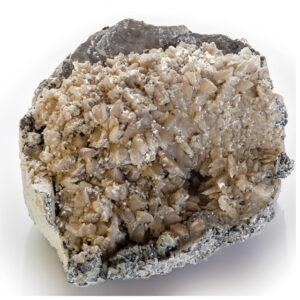
BARYTE
Baryte, also known as barite or barium sulphate, is a mineral composed of barium sulphate. It occurs as crystals ranging from transparent to opaque, and its colour can vary from white to grey, yellow, brown and blue. Baryte is mainly used in the oil and gas industry, but it also plays an important role in grinding.
In the context of grinding, baryte is used as a filler material in a variety of applications. Because of its high density, it is often used as a weighting agent in drilling muds used in oil and gas wells. Baryte is ground into a fine powder to obtain particles of controlled size, which makes it possible to achieve the desired density in drilling muds. These drilling muds containing baryte are used to maintain pressure in the wellbore, prevent unwanted oil and gas flows and facilitate the circulation of drill cuttings to the surface.
In addition to its role in the oil and gas industry, baryte is also used in other fields. For example, in the plastics and rubber industry, baryte is added as a filler to improve the mechanical properties and rigidity of finished products. In the paint industry, baryte is used as a white pigment, providing opacity and corrosion resistance. In the textile industry, baryte can be used as a ballast agent to strengthen fabrics and improve their appearance.
Specialised equipment such as hammer mills, ball mills or jet mills are often used to grind baryte. These machines reduce the baryte to a fine, controlled powder that meets the specific requirements of each application.
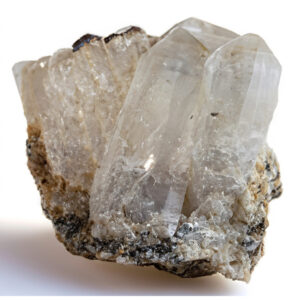
QUARTZ
Quartz is one of the most commonly used minerals in grinding. It plays an essential role thanks to its unique physical and chemical characteristics. As an extremely hard and resistant mineral, quartz is widely used as an abrasive material in grinding and polishing processes.
Quartz consists mainly of silicon dioxide (SiO2) and comes in the form of transparent or translucent crystals. Because of its hardness, which reaches 7 on the Mohs scale, quartz is able to resist wear and abrasion, making it an ideal material for grinding other minerals and rocks.
In the grinding industries, quartz is used in a variety of abrasive tools and equipment. Abrasive wheels, cutting discs, abrasive powders and sandpapers are just a few examples where quartz is used as a grinding agent. These quartz-based abrasive materials are used to reduce the size of solid materials by causing controlled friction and erosion.
Quartz is also used as a grinding material in ball mills and impact mills. In these machines, quartz is introduced in combination with the materials to be ground, and the grinding forces generated by the impacts and friction between the particles reduce the size of the materials to the desired dimensions.
In addition to its use in grinding, quartz has other advantages in related industries. Because of its resistance to high temperatures and chemicals, it is used in metal melting processes and in corrosive environments. Quartz is also used in the electronics and optical industries because of its transparency and thermal conductivity.
It is important to note that quartz can be present in different forms, such as crystalline quartz, amorphous quartz or microcrystalline quartz. Each form may have slightly different characteristics, but all are suitable for grinding due to their hardness and strength.
In conclusion, quartz plays an essential role in grinding because of its hardness, strength and abrasive properties. It is used as an abrasive material in grinding and polishing tools, as well as a grinding material in mills. Quartz offers superior performance in grinding processes, enabling solid materials to be reduced in size in an efficient and controlled manner.
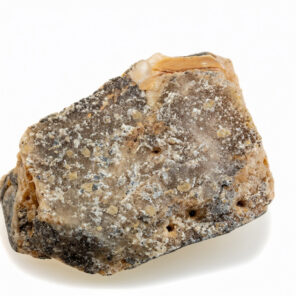
FELDSPAR
Feldspar is a mineral commonly used in grinding due to its favourable physical and chemical properties. It is composed of aluminium silicate and may contain potassium, sodium or calcium. Feldspar plays an essential role in grinding as a grinding and dispersing agent in various industries.
Feldspar is used in the ceramics, glass and paint industries for its role in grinding materials. Thanks to its moderate hardness and resistance to impact, feldspar can effectively grind other minerals and rocks without damaging them. It is often used as a grinding material in ball mills and hammer mills.
One of the main uses of feldspar in grinding is its ability to act as a dispersing agent. When ground to a fine powder, feldspar can be used to disperse and stabilise particles in suspensions and emulsions. This improves the distribution of particles in finished products, such as paints, inks and coatings, and ensures consistent texture and colour.
As well as its role in grinding, feldspar has other advantages in industrial applications. It is used as a filler in plastics and rubber to improve their mechanical properties and reduce production costs. Feldspar is also used as a raw material in the manufacture of glass, where it acts as a flux to lower the melting temperature of the mixture and facilitate the vitrification process.
There are different types of feldspar, including potassium feldspar, sodium feldspar and calcium feldspar. Each type has slightly different properties, making them suitable for specific applications. For example, potassium feldspar is commonly used in the ceramics industry, while sodium feldspar is often used in glassmaking.
In conclusion, feldspar plays an essential role in grinding as a grinding and dispersing agent. It is used to effectively grind other minerals and rocks without damaging them, and to disperse and stabilise particles in various industrial applications. Feldspar also has other advantages in the ceramics, glass, paint and plastics industries. By using different types of feldspar, companies can tailor their grinding processes to the specific needs of each application.
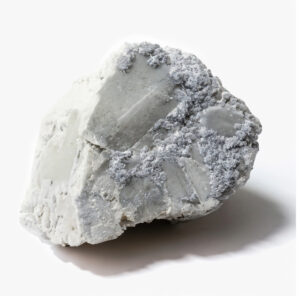
TALC
Talc is a magnesium silicate mineral known for its soft, silky texture. It plays an important role in grinding thanks to its special properties. Talc is widely used as a grinding, lubricating and anti-adhesion agent in various industries.
One of talc’s key characteristics is its soft, powdery texture. Because of this texture, talc is used in dry grinding as a soft material to reduce friction between particles. It is used as a grinding agent in applications where friction reduction is essential, such as in the pharmaceutical and cosmetics industries. In these industries, talc is used to grind raw materials and medicines into a fine powder, facilitating their dispersion and mixing.
Talc is also widely used as a solid lubricant in grinding. Because of its slippery texture, it can effectively reduce friction between moving surfaces. It is used in the mechanical and automotive industries to lubricate moving parts, reduce wear and facilitate the smooth operation of machinery.
Another important role of talc in grinding is its non-stick properties. Due to its lamellar structure, talc has the ability to prevent particles from sticking together or agglomerating. It is used in the food industry to prevent food products from sticking to processing and packaging surfaces. In grinding processes, talc can be used to prevent particles from agglomerating and to maintain a homogenous dispersion.
Talc is also used as a filler in some grinding applications. Because of its soft, powdery nature, it can be blended with other materials to reduce production costs and improve the properties of finished products. For example, in the plastics industry, talc is used as a filler to improve the rigidity and strength of products.
In conclusion, talc plays a crucial role in grinding as a grinding, lubricating and anti-adhesion agent. Its soft, powdery texture reduces friction between particles, improves dispersion and facilitates mixing. Talc is used in a variety of industries, including pharmaceuticals, cosmetics, mechanical engineering and food. Thanks to its unique properties, talc helps improve the performance of grinding processes and finished products.
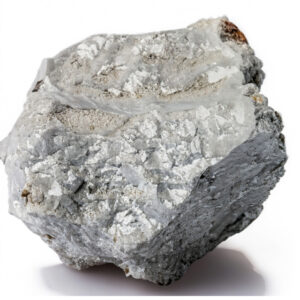
CALCIUM CARBONATE
Calcium carbonate is a mineral widely used in grinding due to its advantageous physical and chemical properties. It comes in the form of a fine powder or crystals and is made up of calcium, carbon and oxygen. Calcium carbonate plays an essential role as a filler in many industries.
One of the most common uses of calcium carbonate in grinding is as a filler. Because of its whiteness, abundance and low cost, calcium carbonate is added to many products to improve their properties. It is used in the plastics, paint, ink, paper and adhesive industries. Adding calcium carbonate increases the volume of finished products while reducing production costs. It also improves mechanical properties such as rigidity, tensile strength and durability.
In the grinding process, calcium carbonate is reduced to a controlled particle size to achieve optimum particle size distribution. Ball mills, hammer mills and jet mills are commonly used to achieve this size reduction. Ground calcium carbonate is then used in a variety of industrial applications.
Ground calcium carbonate is also used in the food industry as an additive. It can be used as a strengthening agent in dairy products, beverages and bakery products. In addition, it is used as a nutritional supplement to provide calcium in foods and beverages.
Another important role of calcium carbonate in grinding is its use as a neutralising agent. Because of its alkaline nature, calcium carbonate can be used to neutralise acids in many industrial processes. For example, in the chemical industry, it is used to adjust the pH of solutions and reduce acidity.
In conclusion, calcium carbonate plays an essential role in grinding as a filler, additive and neutraliser. It is widely used in the plastics, paint, ink, paper and adhesive industries to improve mechanical properties and reduce production costs. Ground calcium carbonate is also used in the food and chemical industries. Grinding calcium carbonate produces the optimum particle size to meet the specific requirements of each industrial application.
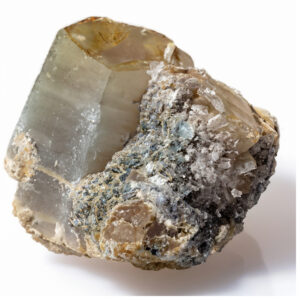
GYPSUM
Gypsum is a calcium sulphate hydrate-based mineral that plays an important role in grinding and various industrial applications. It comes in the form of transparent crystals or white to grey granular masses. Gypsum is used in grinding for its ability to be reduced to a fine powder and for its specific properties.
One of the key roles of gypsum in grinding is its use as a retarding agent in the cement industry. When added to cement, gypsum slows setting and hardening, allowing for better handling and long-term strength. Gypsum is ground into a fine powder to facilitate its incorporation into cement during the manufacturing process.
Gypsum also plays a role in grinding as a filler material in various construction applications. Because of its fine texture and non-reactive nature, ground gypsum is used as a filler in plasterboard, surface plasters and pointing compounds. Grinding gypsum produces a fine powder that can be mixed with other materials to improve mechanical properties and workability.
In the chemical industry, ground gypsum is used as a source of calcium and sulphur in the production of fertilisers. Gypsum is ground into a fine powder to make it easier to dissolve in soils and make it available to plants.
Another use for ground gypsum is in the building materials industry. Ground gypsum can be used as a base material for roads, lightweight concrete slabs and insulation products. Grinding enables the desired granulometry to be obtained for each specific application.
It is important to note that gypsum is a relatively soft mineral, having a hardness of 2 on the Mohs scale. Because of its softness, gypsum can be ground with relative ease, requiring less robust grinding equipment than some other minerals.
In conclusion, gypsum plays an important role in grinding as a set retardant in the cement industry, as a filler in construction products, as a source of calcium and sulphur in the chemical industry, and as a base material in building materials. Gypsum is ground into a fine powder that meets the specific requirements of each industrial application.
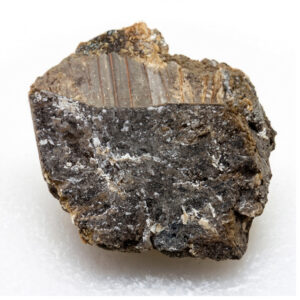
MICA
Mica is a group of minerals characterised by their layered structure, composed of potassium, aluminium and magnesium silicate. Mica plays an important role in grinding thanks to its special properties. It is used as a reinforcing agent, as an anti-caking agent and in specific applications.
One of the key roles of mica in grinding is its use as a reinforcing agent. Due to its layered structure, mica has excellent resistance to bending and abrasion. It is used in the plastics, paint, coatings and rubber industries to reinforce materials and improve their mechanical properties. Ground mica is mixed with other materials to increase the strength, rigidity and durability of finished products.
Mica is also used as an anti-caking agent in various industrial applications. Because of its layered structure and surface properties, mica prevents particles from sticking together or agglomerating. It is used in the plastics, paints and coatings industries to ensure uniform dispersion of pigments and fillers, improving the quality of finished products.
Ground mica is used in the cosmetics industry for its reflective properties and shine. It is used in make-up products such as eyeshadows, lipsticks and powders to provide a shimmering, luminous finish. Mica is ground to a controlled particle size, making it easy to incorporate into cosmetic formulations.
Mica is also used in the electronics and electrical industries for its ability to insulate electricity and withstand high temperatures. It is used in capacitors, cables, insulators and other electronic components. Ground mica is mixed with other materials to form solid, heat-resistant electrical insulators.
In conclusion, mica plays an important role in grinding as a reinforcing agent, anti-caking agent and for its brilliance. It is used in the plastics, paint, coatings, cosmetics and electronics industries. Mica grinding produces particles of controlled size, meeting the specific needs of each industrial application.
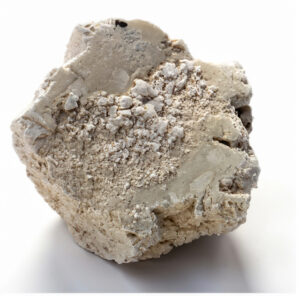
KAOLIN
Kaolin is a clay mineral that plays an important role in grinding due to its specific properties. Composed mainly of aluminium silicate clay, kaolin comes in the form of a fine powder and is widely used in a variety of industrial applications.
One of the key roles of kaolin in grinding is its use as a grinding agent in the paper industry. Kaolin is ground into a fine powder to obtain an optimum particle size, which ensures a uniform dispersion in the paper pulp. This improves paper quality by increasing strength, opacity and gloss. Kaolin is also used as a filler to reduce production costs and improve printing properties.
Kaolin also plays an important role in the ceramics industry. Because of its low shrinkage and plasticity, kaolin is used as a raw material in the manufacture of ceramics. It is ground to a controlled particle size, making it easy to mix with other ceramic materials. Grinding kaolin produces a fine, homogeneous texture, which improves the moulding, strength and finishing properties of ceramic products.
Kaolin is also used in the plastics and rubber industry as a reinforcing agent. When added to plastic or rubber formulations, kaolin improves the mechanical properties and dimensional stability of finished products. Kaolin is ground to the optimum particle size to ensure uniform dispersion in the polymer matrix.
Kaolin is also used in the cosmetics industry for its absorbent properties and softness. It is ground into a fine powder and used in cosmetic products such as powders, foundations and baby products. Kaolin absorbs excess sebum and leaves the skin feeling soft.
In conclusion, kaolin plays an important role in grinding as a grinding, reinforcing and filling agent. It is used in the paper, ceramics, plastics, rubber and cosmetics industries. Kaolin is ground to a controlled particle size to meet the specific needs of each industrial application.
It is important to note that the grinding of industrial minerals may require the use of specific techniques and equipment, such as ball mills, hammer mills and impact crushers. Each mineral has its own physical and chemical characteristics, which influence the choice of appropriate grinding methods.
In conclusion
The grinding of industrial minerals plays an essential role in various industrial sectors. Minerals such as quartz, feldspar, talc, calcium carbonate, gypsum, mica and kaolin offer unique properties that improve grinding processes and end-product performance. Knowledge of these different types of industrial minerals enables companies to select the materials best suited to their specific grinding needs.
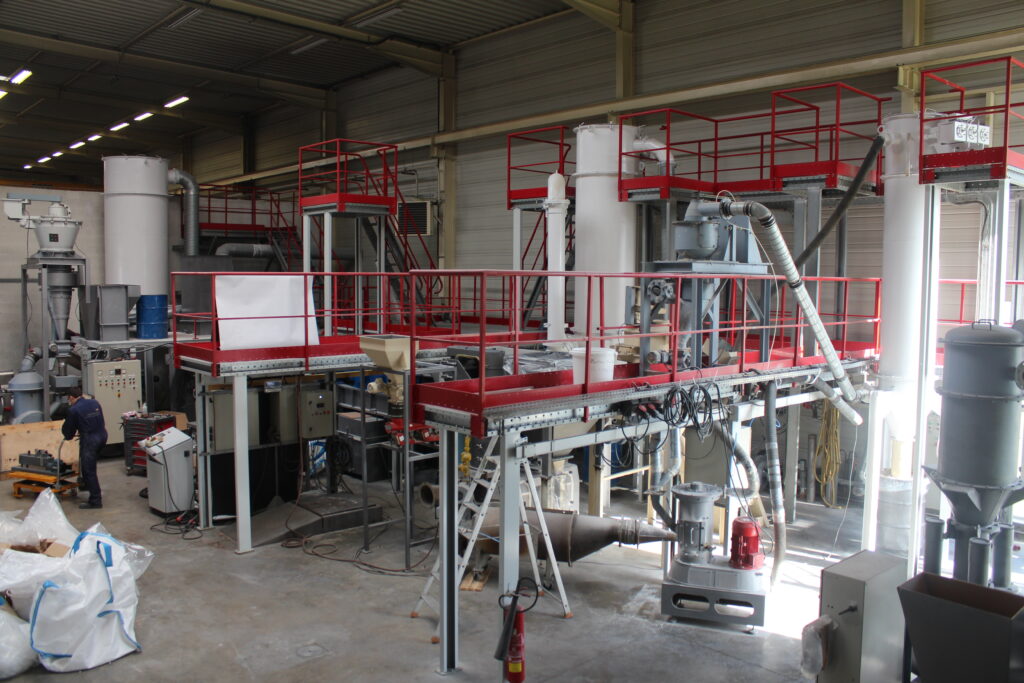
Need help configuring your process?
Benefit from the advice of the POITTEMILL group, experts in industrial minerals processing, drying and classification technology.
Our laboratory and testing centre in France offers numerous opportunities to test machines, parameters and processes, at pilot and full scale, to ensure that the quality of your products and the efficiency of your operations generate maximum return on investment for your business.
